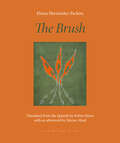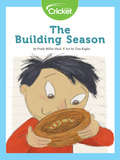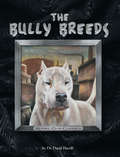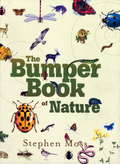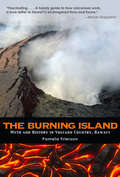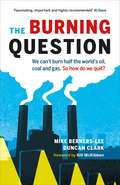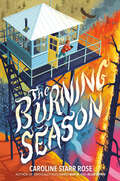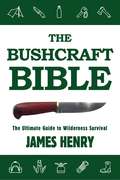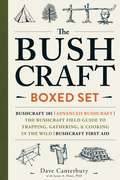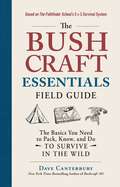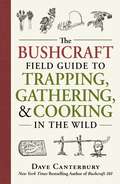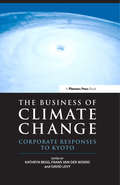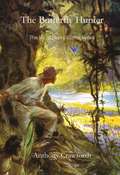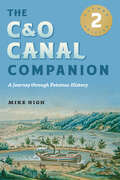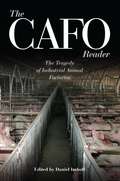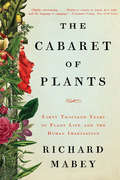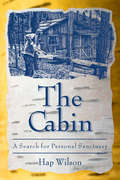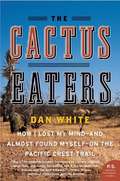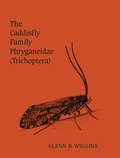- Table View
- List View
The Brush: Poems
by Eliana Hernández-PachónA wise, visionary debut on ecological and human resistance, perfect for readers of Joy Harjo and Tracy K. Smith, and fans of the earth-body artwork of Ana MendietaThe Brush is an incantatory, fearless exploration of collective trauma – and its horrific relevance in today&’s Colombia, where mass killings continue. Told from the voices Pablo, Ester, and the Brush itself, Hernández-Pachón&’s poem is an astounding response to a traumatic event in recent Colombian history: the massacre in the village of El Salado between February 16 and 21, 2000. Paramilitary forces tortured and killed sixty people, interspersing their devastating violence with music in the town square.Pablo Rodríguez steps thirteen paces out into the night and buries a wooden box. Its contents: a chain, a medallion, a few overexposed photographs, and finally, a deed. He burrows into the ground without knowing quite why, but with the certainty of a heavy change pressing through the air, of fear settling &“like a cat in his throat.&” Meanwhile, his wife Ester – a sharpshooter and keeper of all village secrets – slips into her fifth dream of the night. As Ester tosses and Pablo pats his fresh mound of earth, another character emerges in Eliana Hernández-Pachón&’s vivid and prophetic triptych.The Brush is a tangled grove, a thicket of vines, an orchid pummeled with rain. It is also an extraordinary depiction of ecological resistance, of the natural world that both endures human cruelty and lives on in spite of it.
The Building Season
by Prudy Miller HockA young boy is too little to help his dad work on the house. But he's just the right size to assist the birds in building their nests.
The Bully Breeds
by David HarrisDiscover the real bully dogs and the truth about these often-misunderstood yet ever-popular canines. The whole fraternity of bully breed owners and devotees will revel in this long-overdue celebration of the six bull-and-terrier dogs that are the focus of this Kennel Club Classic edition.
The Bumblebee and the Ram
by Barry RudnerA character-building story humorously presented. A bumblebee who--by laws of physics--should not be able to fly is fixed for flight by Ram, the computer, only to find that he never had to change at all in order to fly.
The Bumper Book of Nature: A User's Guide to the Outdoors
by Stephen MossWhen was the last time you climbed a tree? Picked blackberries? Held a snail race? Made maple syrup candy, an old-fashioned quill pen from a bird feather you found, or a plaster cast of an animal track? If the answer is "can't remember" or quite possibly "never," The Bumper Book of Nature will inspire you to get outdoors and enjoy the very best kind of free entertainment for you and your family. Who wouldn't love to discover a colorful butterfly hibernating in a woodshed for the winter or look at a snowflake under a magnifying lens? In warmer weather, why not explore rock pools by the seaside, pick wild meadow flowers (and then fry up elderflower fritters!), or go on a city safari? Whether you live in the heart of the city, the suburbs, or the deepest countryside,The Bumper Book of Nature will bring out the child in you with its treasure trove of offbeat, playful nature activities arranged by season. With lovely full-color illustrations as well as related trivia, quotes, and bits of poetry, it's a wonderful keepsake as well as a one-of-a-kind field guide.
The Burning
by Richard SnowTo Scott Keegan, a traveling salesman working his way through Minnesota during the hottest summer on record, Hinckley was no different from any other fair-sized lumber town. For Jim Root, aging locomotive engineer on the St. Paul & Duluth, it simply marked the halfway point on an increasingly difficult run. For lovely young Betty Langdon, it was half home, half prison. For ten-year-old Jemmy Stockholm it was a dull place to spend the summer, but the only place he knew. None of them -none of Hinckley's 2,000 people-knew the town was soon to be engulfed in a cataclysm that would forever change their lives. As the temperature continued to rise throughout that summer, a smoky haze hung over the dry forests of Pine County, Minnesota. The underbrush smoldered .. , and slowly the flames spread. Until early one September morning they ignited a raging wildfire. The tragedy of that day unfolds in Richard Snow's gripping new novel. Hundreds would die that afternoon as the fire storm swept through the town. And heroes would be born. Ordinary people would find themselves possessed of extraordinary courage as they fought to escape the inferno. THE BURNING: a novel that blazes with period adventure as it tells the true story of the men and women who battled a terrifying natural disaster.
The Burning Island
by Pamela FriersonWesterners-from early missionaries to explorers to present-day artists, scientists, and tourists-have always found volcanoes fascinating and disturbing. Native Hawaiians, in contrast, revere volcanoes as a source of spiritual energy and see the volcano goddess Pele as part of the natural cycle of a continuously procreative cosmos. Volcanoes hold a special place in our curiosity about nature.The Burning Island is an intimate, multilayered portrait of the Hawaiian volcano region-a land marked by a precarious tension between the harsh reality of constant geologic change, respect for mythological traditions, and the pressures of economic exploitation. Pamela Frierson treks up Mauna Loa, the world's largest active volcano, and Kilauea to explore how volcanoes work, as well as how their powerful and destructive forces reshape land, cultures, and history. Her adventures reveal surprising archeological ruins, threatened rainforest ecosystems, and questionable real estate development of the islands. Now a classic of nature writing, Frierson's narrative sets the stage for a larger exploration of our need to take great care in respecting and preserving nature and tradition while balancing our ever-expanding sense of discovery and use of the land.
The Burning Island
by Pamela FriersonWesterners-from early missionaries to explorers to present-day artists, scientists, and tourists-have always found volcanoes fascinating and disturbing. Native Hawaiians, in contrast, revere volcanoes as a source of spiritual energy and see the volcano goddess Pele as part of the natural cycle of a continuously procreative cosmos. Volcanoes hold a special place in our curiosity about nature.The Burning Island is an intimate, multilayered portrait of the Hawaiian volcano region-a land marked by a precarious tension between the harsh reality of constant geologic change, respect for mythological traditions, and the pressures of economic exploitation. Pamela Frierson treks up Mauna Loa, the world's largest active volcano, and Kilauea to explore how volcanoes work, as well as how their powerful and destructive forces reshape land, cultures, and history. Her adventures reveal surprising archeological ruins, threatened rainforest ecosystems, and questionable real estate development of the islands. Now a classic of nature writing, Frierson's narrative sets the stage for a larger exploration of our need to take great care in respecting and preserving nature and tradition while balancing our ever-expanding sense of discovery and use of the land.
The Burning Question
by Bill Mckibben Duncan Clark Mike Berners-LeeThe Burning Question reveals climate change to be the most fascinating scientific, political and social puzzle in history. It shows that carbon emissions are still accelerating upwards, following an exponential curve that goes back centuries. One reason is that saving energy is like squeezing a balloon: reductions in one place lead to increases elsewhere. Another reason is that clean energy sources don't in themselves slow the rate of fossil fuel extraction.Tackling global warming will mean persuading the world to abandon oil, coal and gas reserves worth many trillions of dollars - at least until we have the means to put carbon back in the ground. The burning question is whether that can be done. What mix of politics, psychology, economics and technology might be required? Are the energy companies massively overvalued, and how will carbon-cuts affect the global economy? Will we wake up to the threat in time? And who can do what to make it all happen?
The Burning Season
by Caroline Starr RoseIn this riveting coming-of-age survival story in verse perfect for fans of Alan Gratz, a fire lookout-in-training must find her courage when a wildfire breaks out on her watch.Twelve-year-old Opal has a secret: she&’s deathly afraid of fire. Still Opal is preparing to become a fourth-generation lookout on Wolf Mountain, deep in the New Mexico wilderness. She, Mom, and Gran live at ten thousand feet in a single room at the top of a fire tower. They are responsible for spotting any hint of smoke before it becomes an uncontrollable blaze. Instead of training for the lonely life of a lookout, Opal wishes she could be starting seventh grade in Silver City, attending real classes with kids her own age and even going to afterschool clubs like FFA. But Wolf Mountain has other ideas. When Mom makes the long trek to town for supplies and Gran goes missing, Opal is the only one to spot a tell-tale spiral of smoke moving up the mountainside. She&’ll have to be braver than she&’s ever been as she heads into the woods, beyond Wolf Ridge&’s old blackened burn scar, to face down a fire on her own. But when a fire is what took her father away, and Opal herself knows the sting of smoke and lick of flames, how can she be brave enough when it really counts?
The Bushcraft Bible: The Ultimate Guide to Wilderness Survival
by James HenryAn extensive guide to hardcore wilderness survival
The Bushcraft Boxed Set: Bushcraft 101; Advanced Bushcraft; The Bushcraft Field Guide to Trapping, Gathering, & Cooking in the Wild; Bushcraft First Aid (Bushcraft)
by Dave Canterbury Ph.D. Jason A. HuntThe Bushcraft Boxed Set brings together four titles from wilderness expert and New York Times bestselling author Dave Canterbury.The collection includes: Bushcraft 101: The primer to wilderness survival based on the author’s 5Cs of Survivability (cutting tools, covering, combustion devices, containers, and cordages) Advanced Bushcraft: Takes it to the next level with self-reliance skills that teach you how to survive with little to no equipment The Bushcraft Guide to Trapping, Gathering, and Cooking in the Wild: Provides everything you need to know about packing, finding, and preparing food while trekking Bushcraft First Aid: Written with Jason A. Hunt, PhD, it’s the go-to first aid resource for anyone headed into the woods With this boxed set, you’ll be prepped and ready for your next outdoor adventure—wherever it takes you!
The Bushcraft Essentials Field Guide: The Basics You Need to Pack, Know, and Do to Survive in the Wild (Bushcraft)
by Dave CanterburyLearn everything you need to know about outdoor survival so you can make it through any situation from top bushcraft expert and New York Times bestselling author Dave Canterbury.For years, Dave Canterbury has been teaching outdoor enthusiasts how to survive in the wild, and truly enjoy the experience. The Bushcraft Essentials Field Guide distills these teachings into the key takeaways campers and hikers need to know when they&’re out in the woods. How to start a fire. Where to build your shelter. What to put in your pack. Dave&’s advice is now right at your fingertips in the most accessible Bushcraft title to date. You can quickly flip and find answers to pressing questions about wilderness survival. From first aid to navigation to setting up camp, it&’s all provided in this small, portable book that&’s perfect whether you&’re on a day-hike, overnight, or multi-day trek. The Bushcraft Essentials Field Guide is what you need to know when you need to know it and exactly what you need for your next outdoor adventure.
The Bushcraft Field Guide to Trapping, Gathering, and Cooking in the Wild: Bushcraft 101; Advanced Bushcraft; The Bushcraft Field Guide To Trapping, Gathering, And Cooking In The Wild; Bushcraft First Aid (Bushcraft)
by Dave CanterburyWhat to eat, where to find it, and how to cook it! Renowned outdoors expert and New York Times bestselling author Dave Canterbury provides you with all you need to know about packing, trapping, and preparing food for your treks and wilderness travels. Whether you're headed out for a day hike or a weeklong expedition, you'll find everything you need to survive--and eat well--out in the wild. Canterbury makes certain you're set by not only teaching you how to hunt and gather, but also giving you recipes to make while on the trail. Complete with illustrations to accompany his instructions and a full-color photo guide of plants to forage and those to avoid, this is the go-to reference to keep in your pack. The Bushcraft Field Guide to Trapping, Gathering, and Cooking in the Wild helps you achieve the full outdoor experience. With it, you'll be prepared to set off on your trip and enjoy living off the land.
The Business of Climate Change: Corporate Responses to Kyoto
by David Levy Kathryn Begg FRANS VAN DER WOERDIn recent years climate change has become a leading issue on both the business and political agenda. With the Kyoto Protocol to the UN Framework Convention on Climate Change now ratified, business is bracing itself for the reality of serious regulation on the reduction of greenhouse gas emissions.The Business of Climate Change presents a state-of-the-art analysis of corporate responses to the climate change issue. The book describes and assesses a number of recent business approaches that will help to identify effective strategies and promote the dissemination of proactive corporate practices on climate change worldwide. By identifying the factors that cause companies to pursue low-carbon strategies and support the Kyoto process, the book will also be helpful to governments in formulating policy.Business and industry have a crucial role to play in the implementation of the Kyoto Protocol. They are major emitters of greenhouse gases, and pressure is mounting for them to engage in a range of mitigation strategies, from emission inventorying and trading schemes to investments in low-carbon technologies. Behind the scenes a number of companies have started to develop strategies to curtail greenhouse gas emissions.These strategies can be very diverse in nature. At a political level, companies try to influence policy implementation and, more specifically, to test ideas in anticipation of possible regulation on the climate change issue. At a more practical level, there are a burgeoning number of initiatives to conserve energy use in production, transportation and buildings, to develop renewable sources of energy, to measure carbon emissions and sequestration at a detailed level, and to develop various markets for trading carbon credits among companies and countries. Some technologies, such as hybrid cars and compact fluorescent lighting, are now market realities.Common to all of these initiatives is that they operate in an environment of high complexity and uncertainty. The political implementation of the Kyoto Protocol remains uncertain and many details remain unspecified. Economic instruments such as emission trading are favoured, but their mechanisms are still hotly debated and the future price of credits is unknown. New markets for low-emission products and technologies are beginning to appear, but there are currently few regulatory drivers to assist their development. The impact of potential regulation on business will vary tremendously between companies and sectors. The fossil fuel and energy sectors fear the economics of action, while sectors such as insurance and agriculture fear the economics of inaction. Combined with the remaining uncertainties about what form climate change may take, corporate responses to reduce risks have to differentiate between sectors and have to be flexible. For individual companies, these big uncertainties demand new thinking and contingency planning.The Business of Climate Change is split into four sections: "Introduction and overview" presents a broad perspective on business and climate policies
The Business of Waste
by Raymond G. Stokes Roman Köster Stephen C. Sambrook Raymond G. Stokes Roman KösterThe advent of consumer societies in the United Kingdom and West Germany after 1945 led to the mass 'production' of garbage. This book compares the social, cultural and economic fallout of the growing volume and changing composition of waste in the two countries from 1945 to the present through sustained attention to changes in the business of handling household waste. Though the UK and Germany are similar in population density, degrees of urbanisation, and standardisation, the two countries took profoundly different paths from low-waste to throwaway societies, and more recently, towards the goal of 'zero-waste'. The authors explore evolving balances between public and private provision in waste services; the transformation of public cleansing into waste management; the role of government legislation and regulation; emerging conceptualisations of recycling and resource recovery; and the gradual shift of the industry's regulatory and business context from local to national and then to international.
The Butterfly Hunter: The Life Of Henry Walter Bates
by Anthony CrawforthThis is the epic, true and long overdue story of the young explorer who put the first ever case for the creation of a new species, providing what Charles Darwin called the "beautiful proof" for Natural Selection.The major discovery of Batesian Mimicry was developed from Bates's fascinating 11-year journey and study of butterflies in the Amazon rainforest. He noted how certain animals adopt the look of others to deceive predators and gain an advantage to survive. Little known to the public, Bates made other crucial contributions to biology: he collected over 14,000 specimens, of which over 8,000 were at the time new to science. He went on to become the administrator for the Royal Geographical Society and transformed it into an institution which combined exploration with academic research and was responsible for placing geography on the school curriculum. This important book reassesses Bates's life and finally places both the man and his work in their rightful place alongside the other greats.
The C&O Canal Companion: A Journey through Potomac History
by Mike HighAn indispensable guide to a regional treasure—now thoroughly updated and expanded.A comprehensive guide to one of America's unique national parks, The C&O Canal Companion takes readers on a mile-by-mile, lock-by-lock tour of the 184-mile Potomac River waterway and towpath that stretches from Washington, D.C., to Cumberland, Maryland, and the Allegheny Mountains. Making extensive use of records at the National Archives and the C&O Canal Park Headquarters, Mike High demonstrates how events and places along the canal relate to the history of the nation, from Civil War battles and river crossings to the frontier forts guarding the route to the West. Using attractive photographs and drawings, he introduces park visitors to the hidden history along the canal and provides practical advice on cycling, paddling, and hiking—all the information needed to fully enjoy the park's varied delights. Thoroughly overhauled and expanded, the second edition of this popular, fact-packed book features updated maps and photographs, as well as the latest information on lodgings and other facilities for hikers, bikers, and campers on weekend excursions or extended outdoor vacations. It also delves deeper into the history of the upland region, relaying new narratives about Native American settlements, the European explorers and traders who were among the first settlers, and the lives of slaves and free blacks who lived along or escaped slavery via the canal.Visitors to the C&O Canal who are interested in exploring natural wonders while tracing the routes of pioneers and engineers—not to mention the path of George Washington, who explored the Potomac route to the West as a young man and later laid out the first canals to make the river navigable—will find this guide indispensable.
The CAFO Reader
by Daniel ImhoffThe CAFO Reader is possibly the most powerful indictment of factory farming ever compiled, with essays from 30 of the world's leading experts. It also offers a vision for a food system that leaves behind the horrific 20th century model of Concentrated Animal Feeding Operations.The CAFO Reader brings the tragic world of industrial food production into sharp focus with essays on every facet of factory farming: health, environment, animal welfare, labor, politics, economics, and so on. This affordable reader is a companion book to the larger photo-essay volume, CAFO: The Tragedy of Industrial Animal Factories. It is sure to become a relied-upon resource for activists, food policy makers, academics, the media and the general public for many years. This project is a follow-up to the highly successful project Fatal Harvest, published in 2002. It is being supported by an extensive outreach campaign with events around the country.
The CAFO Reader
by Daniel ImhoffThe CAFO Reader is possibly the most powerful indictment of factory farming ever compiled, with essays from 30 of the world's leading experts. It also offers a vision for a food system that leaves behind the horrific 20th century model of Concentrated Animal Feeding Operations.The CAFO Reader brings the tragic world of industrial food production into sharp focus with essays on every facet of factory farming: health, environment, animal welfare, labor, politics, economics, and so on. This affordable reader is a companion book to the larger photo-essay volume, CAFO: The Tragedy of Industrial Animal Factories. It is sure to become a relied-upon resource for activists, food policy makers, academics, the media and the general public for many years. This project is a follow-up to the highly successful project Fatal Harvest, published in 2002. It is being supported by an extensive outreach campaign with events around the country.
The Cabaret of Plants: Forty Thousand Years of Plant Life and the Human Imagination
by Richard Mabey"Highly entertaining…Without being sentimental about it, Mr. Mabey gets us to look at life from the plants' point of view. His science is sound, he's witty, and his language is engaging." —Constance Casey, New York Times The Cabaret of Plants is a masterful, globe-trotting exploration of the relationship between humans and the kingdom of plants by the renowned naturalist Richard Mabey. A rich, sweeping, and wonderfully readable work of botanical history, The Cabaret of Plants explores dozens of plant species that for millennia have challenged our imaginations, awoken our wonder, and upturned our ideas about history, science, beauty, and belief. Going back to the beginnings of human history, Mabey shows how flowers, trees, and plants have been central to human experience not just as sources of food and medicine but as objects of worship, actors in creation myths, and symbols of war and peace, life and death. Writing in a celebrated style that the Economist calls “delightful and casually learned,” Mabey takes readers from the Himalayas to Madagascar to the Amazon to our own backyards. He ranges through the work of writers, artists, and scientists such as da Vinci, Keats, Darwin, and van Gogh and across nearly 40,000 years of human history: Ice Age images of plant life in ancient cave art and the earliest representations of the Garden of Eden; Newton’s apple and gravity, Priestley’s sprig of mint and photosynthesis, and Wordsworth’s daffodils; the history of cultivated plants such as maize, ginseng, and cotton; and the ways the sturdy oak became the symbol of British nationhood and the giant sequoia came to epitomize the spirit of America. Complemented by dozens of full-color illustrations, The Cabaret of Plants is the magnum opus of a great naturalist and an extraordinary exploration of the deeply interwined history of humans and the natural world.
The Cabin: A Search for Personal Sanctuary
by Hap WilsonOne hundred years ago, a young doctor from Cleveland by the name of Robert Newcomb, travelled north to a place called Temagami. It was as far north as one could travel by any modern means. Beautiful beyond any simple expletive, the Temagami wilderness was a land rich in timber, clear-water lakes, fast flowing rivers, mystery and adventure. Newcomb befriended the local Aboriginals — the Deep Water People — and quickly discovered the best way to explore was by canoe. Bewitched by the spirit of an interior river named after the elusive brook trout, Majamagosibi, Newcomb had a remote cabin built overlooking one of her precipitous cataracts. The cabin remained unused for decades, save for a few passing canoeists; it changed ownership twice and slowly began to show its age. The author discovered the cabin while on a canoe trip in 1970. Like Newcomb, Hap Wilson was lured to Temagami in pursuit of adventure and personal sanctuary. That search for sanctuary took the author incredible distances by canoe and snowshoe, through near death experiences and Herculean challenges. Secretly building cabins, homesteading and working as a park ranger, Wilson finally became owner of The Cabin in 2000. Artist, author and adventurer, Hap Wilson is perhaps best known for his ecotourism/travel guidebooks. He has led over 300 wilderness expeditions in Canada, and served as actor Pierce Brosnan’s personal outdoor trainer for the feature film Grey Owl. "This is a complex and fascinating story, beautifully told. At first, it draws us in because the author appears to be living the life we all dream of-a simpler life, close to nature, free from the stress and strain of our consumer culture. But the reality, with its myriad challenges, is what holds our attention and gives the book its substance." — Judith Ruan, Muskoka Magazine
The Cactus Eaters: How I Lost My Mind -- and Almost Found Myself -- on the Pacific Crest Trail
by Dan WhiteThe Pacific Crest Trail stretches from Mexico to Canada, a distance of 2,650 grueling, sun-scorched, bear-infested miles. When Dan White and his girlfriend announced their intention to hike it, Dan's parents--among others--thought they were nuts. How could two people who'd never even shared an apartment together survive six months in the desert with little more than a two-person tent and some trail mix? But when these addled adventurers, dubbed "the Lois and Clark Expedition" by their benevolent trail-guru, set out for the American wilderness, the hardships of the trail--and one delicious-looking cactus--test the limits of love and sanity.
The Cactus Hunters: Desire and Extinction in the Illicit Succulent Trade
by Jared D. MarguliesAn exploration of the explosive illegal trade in succulents and the passion that drives it Cacti and succulents are phenomenally popular worldwide among plant enthusiasts, despite being among the world&’s most threatened species. The fervor driving the illegal trade in succulents might also be driving some species to extinction. Delving into the strange world of succulent collecting, The Cactus Hunters takes us to the heart of this conundrum: the mystery of how and why ardent lovers of these plants engage in their illicit trade. This is a world of alluring desires, where collectors and conservationists alike are animated by passions that at times exceed the limits of law. What inspires the desire for a plant? What kind of satisfaction does it promise? The answer, Jared D. Margulies suspects, might be traced through the roots and workings of the illegal succulent trade—an exploration that traverses the fields of botany and criminology, political ecology and human geography, and psychoanalysis. His globe-spanning inquiry leads Margulies from a spectacular series of succulent heists on a small island off the coast of Mexico to California law enforcement agents infiltrating a smuggling ring in South Korea, from scientists racing to discover new and rare species before poachers find them to a notorious Czech &“cacto-explorer&” who helped turn a landlocked European country into the epicenter of the illegal succulent trade. A heady blend of international intrigue, social theory, botanical lore, and ecological study, The Cactus Hunters offers complex insight into species extinction, conservation, and more-than-human care. Retail e-book files for this title are screen-reader friendly with images accompanied by short alt text and/or extended descriptions.
The Caddisfly Family Phryganeidae (Trichoptera)
by Glenn B. WigginsThe goal of much of the scientific work in natural history museums is to explore and document the biological diversity of the planet. This book is an outstanding example of the museum tradition, offering the results of global research on the biosystematics of one of the families of case-making caddisflies, the Phryganeidae. Throughout his career as a museum curator, Glenn Wiggins has studied and written extensively on caddisflies of the aquatic insect order Trichoptera.Information acquired from field work and museum collections, and from the biological literature is synthesized into a taxonomic monograph. The Phryganeidae are the largest of all the caddisflies, but existing literature has led to problems in species identification, especially in Asia; nine species names were found to be synonyms of others, an unsually high proportion of 10 per cent of the described species. Fifteen genera comprising seventy-four species are recognized here, including three that are new to science. Generic keys are provided for adults, larvae, and pupae; keys to species are given for adults. Morphological structures used in the keys are fully illustrated in 246 line drawings and half-tone plates. Distribution maps are provided for most of the North American species.Hypotheses are inferred for the phylogeny of the genera, and for the species in each genus; the fossil history of the Phryganeidae is reviewed. From this base, the biogeography of the family is interpreted. Of evolutionary interest is an extraordinary relationship between larval case-making and pupation behaviour and the degradation of functional pupal mandibles. Contrasting colour patterns of the wings in some species of the Phryganeidae are interpreted for the first time in the Trichoptera as part of a protective warning system to deter predators. Variation in genitalic morphology far exceeding normal species limits is documented in two species, and the evolutionary implications are considered. Combined with fossil evidence that the Phryganeidae are the oldest of the case-making Trichoptera still extant, several of the atypical morphological and behavioural attributes discussed in this book can be interpreted as plesiomorphic, placing the Phryganeidae in a pivotal position for inferring phylogeny in the Trichoptera. A revised classification embodying much new information is proposed for the family Phryganeidae.The taxonomy, biology, and evolution of no other family of caddisflies has been treated as extensively.
